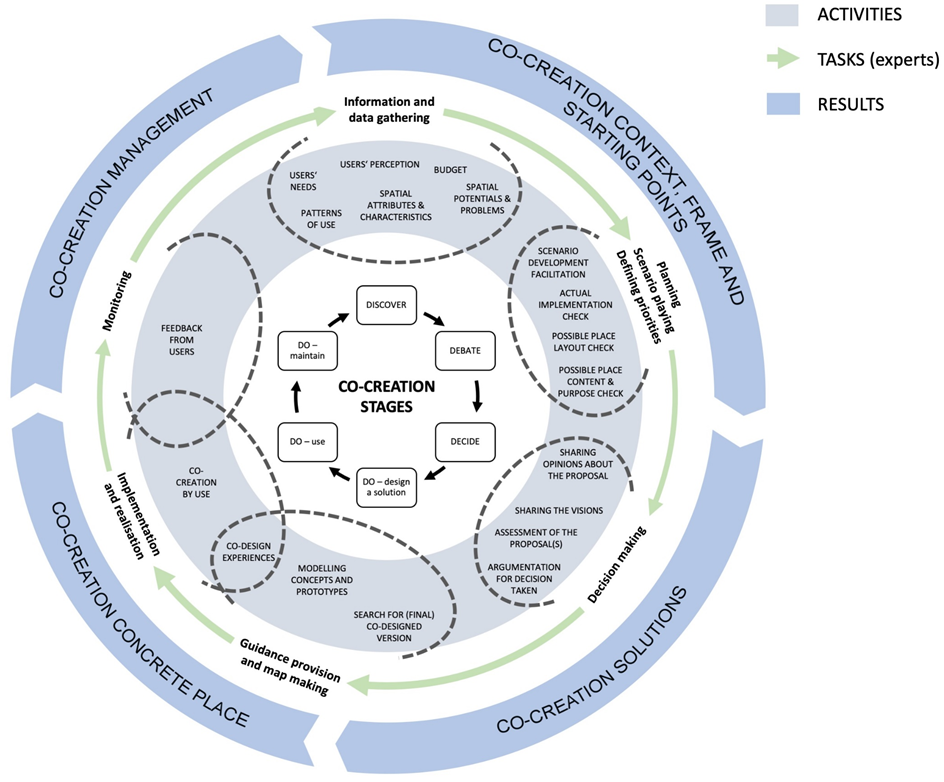Authors: Barbara Goličnik Marušić, Ina Šuklje Erjavec, Vita Žlender
To facilitate the smoothness of a co-creative process, different kinds of participatory tools, methods and technologies have been developed, most of them aiming at being easy to use and available to users anywhere and anytime. Commonly, it is still urban planners who are designing and initiating the process, so the selection of participatory tools mainly depends on them. However, the actors involved in the co-creation and the variety and relationships among them are of crucial importance for the success of the creation process. The relationship between all involved is a partnership, though some literature stresses the communication gaps between various actors involved.
Type of Activities and Tasks of Actors
We defined specific tasks of planning experts and users as the actors involved in the process, and further develop the activities and tasks for each co-creation stage (Figure 1).

Discover. In this phase, activities performed mainly relate to:
- Patterns of use: gathering information about the patterns of how people use a place to provide an overview of behaviours, activities and movements of people in POS;
- Users’ needs: collecting information on citizens’ needs, wishes, preferences, complaints, and more;
- Users’ perception: collecting information on citizens’ perceptions of the environment;
- Spatial potential and problems: information on spatial potentials, problems, obstacles, etc.;
- Using databases: spatial attributes and characteristics information on spatial attributes and other characteristics; and
- Budget: data on budgetary possibilities.
Debate. In the debate phase, most important activities refer to:
- Scenario development facilitation: facilitating the development of the predictions and scenarios to help identify parameters that may impact on people’s use of a POS;
- Actual implementation check: checking financial possibilities and calculations for the implementation and management of different scenarios as possible realisations;
- Possible place layout check: recognizing or understanding place types and their attributes to support the debate about priorities and possibilities once/if implemented; and
- Possible place content and purpose check: recognizing ideas and suggestions shared by the public and other stakeholders about the purpose, vision, aims, possibilities, problems, preferences and priorities of a place once/if implemented
Decide. In this phase, the final decision is met, and the solutions are co-created. Main activities of this phase are:
- Sharing the visions: expressed comments and visions from diverse actors involved;
- Sharing opinions about the proposal(s): opinions about the proposal(s) based on results from the previous phase;.
- Assessment of the proposal(s): appropriateness of the proposed solution(s) against selected criteria; and
- Argumentation for the decision taken: arguing and evaluation steps for decisions taken.
Do. The final phase encompasses co-designing, delivering and implementing a solution, including the actual design use as well as its maintenance as a precondition for the long-term attractiveness and conduciveness for usage. In this phase, the activities may refer to:
- Search for (final) co-designed version: ways for searching for actual co-design solutions;
- Modelling concepts and prototypes: ways for and types of modelling concepts and virtual prototypes;
- Co-design experiences: co-design the site-specific experiences of various actors;
- Co-creation by use: ways of use and types of actual experiences in co-creation according to use; and
- Feedback from users: gathering feedback from users.
References:
- Žlender, V, Šuklje Erjavec, I & Goličnik Marušić, B (2020). Digitally Supported Co-creation within Public Open Space Development Process: Experiences from the C3Places Project and Potential for Future Urban Practice. Planning Practice and Research. DOI: 10.1080/02697459.2020.1829286.
- Goličnik Marušić, B., & Šuklje Erjavec, I. (2020) Understanding co-creation within urban open space development process, in: C. Smaniotto Costa, M. Mačiulienė, M. Menezes, & B. Goličnik Marušić. (Eds) Co-Creation of Public Open Places. Practice—Reflection—Learning. C3Places Project Lisbon: Lusófona University Press. ISBN 978-989-757-125-1. DOI https://doi.org/10.24140/2020-sct-vol.4-1.1.
- Šuklje Erjavec, Ina, and Ruchinskaya, Tatiana (2019). A Spotlight of Co-Creation and Inclusiveness of Public Open Spaces. In CyberParks – The Interface Between People, Places and Technology, edited by Smaniotto Costa C. et al. Lecture Notes in Computer Science, vol 11380. Springer, Cham.
